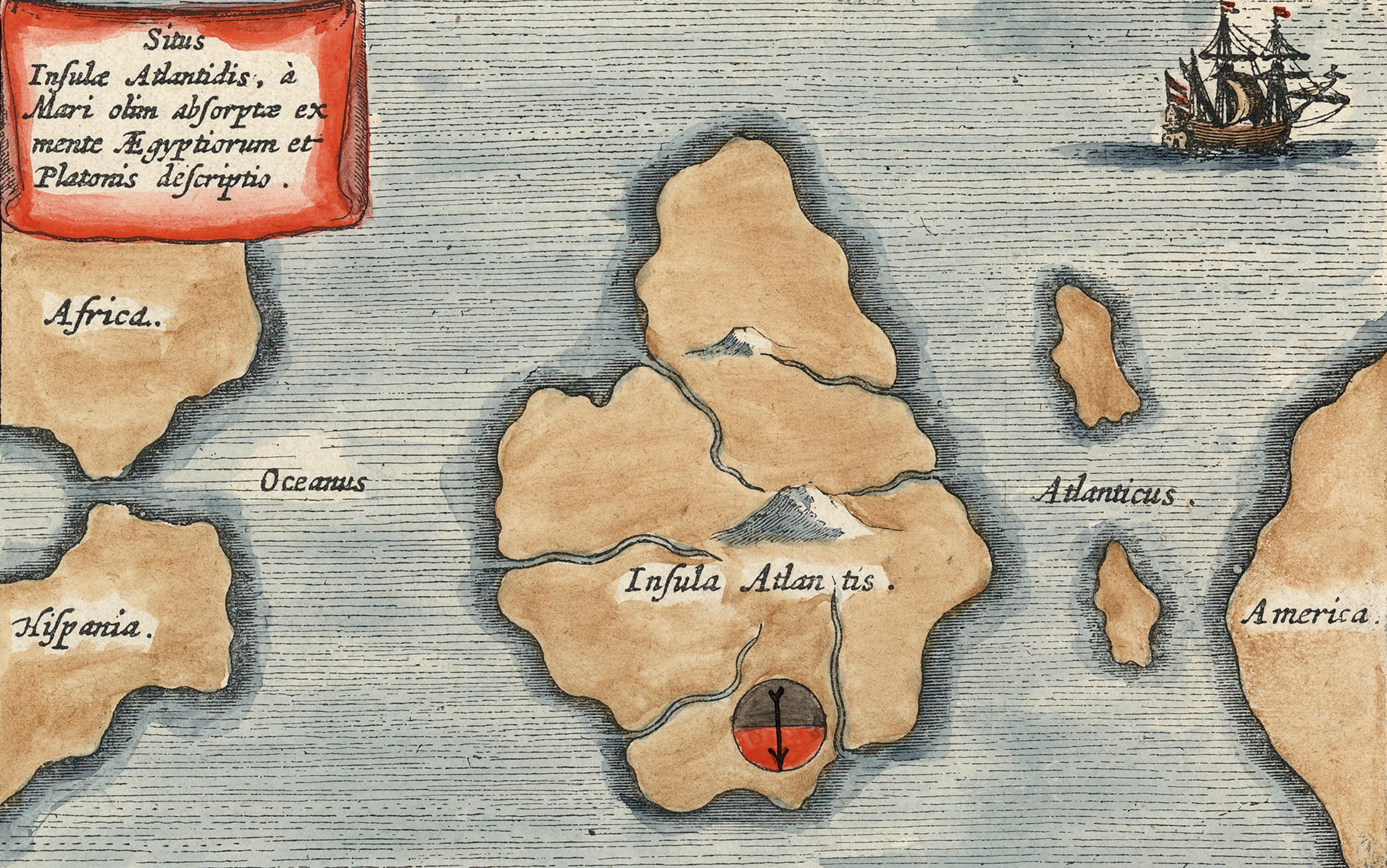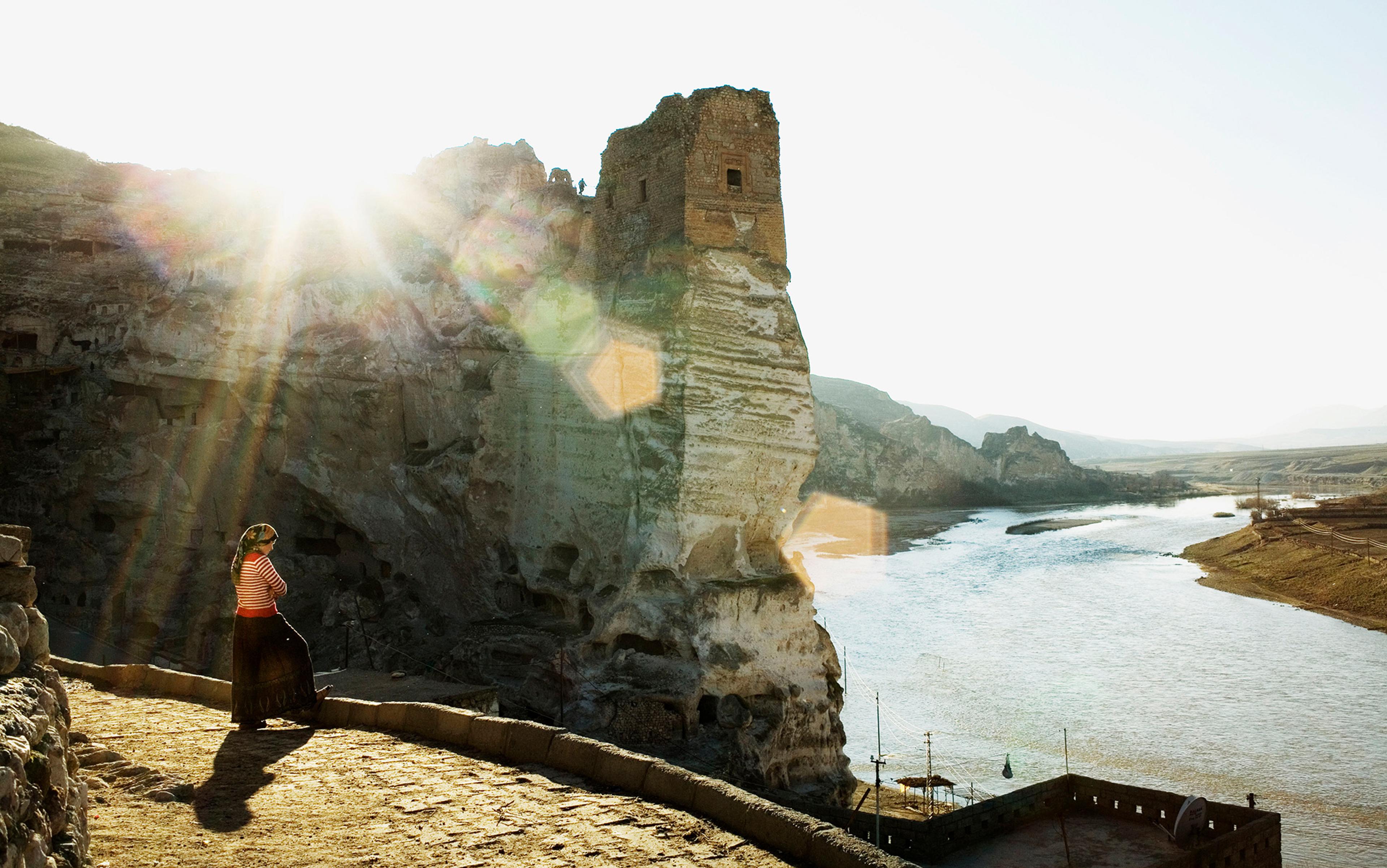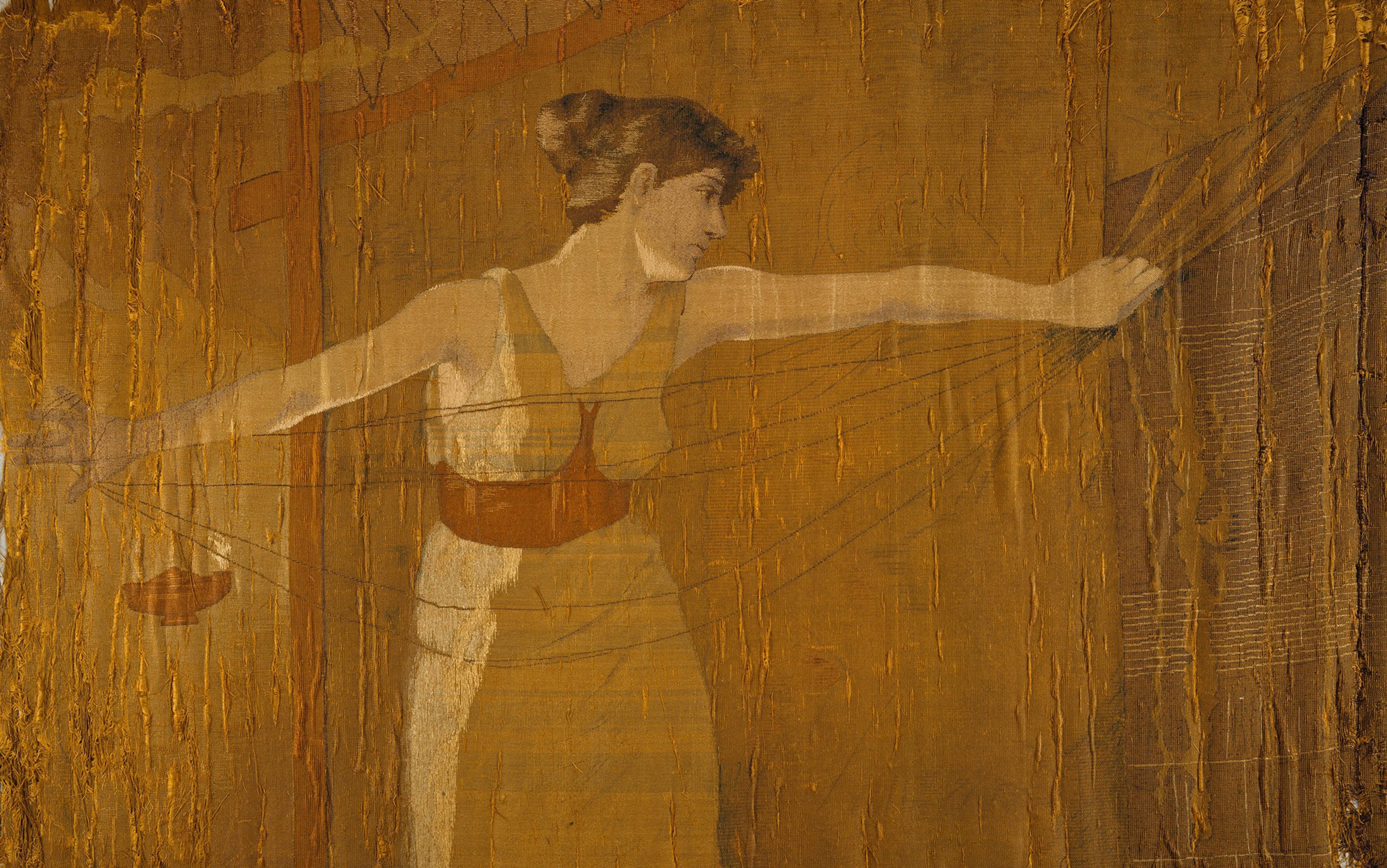Monsters were not normally welcome in ancient Greek wedding processions, especially at weddings attended mostly by the Olympian gods. Yet there he is, on an archaic mixing bowl called a dinos, painted by Sophilos around 600 BC: a horned figure, half-man half-eel, slithering along right behind a chariot that bears the very proper goddesses Athena and Artemis. He seems ludicrously out of place, more so because of the creatures he holds in his hands: in his right, a flopping fish, and in his left, an eel, its dorsal fin patterned to resemble his own. Beside him, Sophilos has scratched the figure’s name into the glaze of the dinos. It’s Okeanos – or Ocean, in our Latinised, then Anglicised version of the name – who disrupts the otherwise solemn parade, a celebration of the marriage of Peleus, a mortal, to Thetis, a sea-goddess.
This dinos, today housed in the British Museum, is remarkable for a number of reasons, not least because of the inscription ‘Sophilos drew me’, the oldest known artist’s signature in the Western tradition. But the prominence it gives to Ocean is, for me at least, chief among its achievements. Sophilos has made this figure slightly larger than the others, and has allowed the long horn, even the top of the head, to break through the top of the horizontal bend that otherwise contains them. He has drawn the sinuous tail so that it crosses the line of march, forcing Hephaestus and his horse, two places to the rear, to tread carefully so as to avoid tripping over it. Like the fish out of water he holds, Ocean does not fit in, either with his own divine family or with the artistic conventions that have been used to portray him. Propriety demanded his presence at this wedding – Thetis, as a marine deity, was after all a close relation, perhaps even his daughter – yet there is nothing proper about him, nor about the slimy, comically out-of-place friends he has brought along to share in the festivities.
One has to admire Sophilos’s courage in undertaking what was surely one of the most challenging portrait assignments of all time. The Greeks did not yet have iconographic traditions of how Ocean should be drawn, but plenty of complex ideas as to what he – it? – represented. To them, Ocean was at once a monster, a god, and a ‘river’ that ran in a circle around the world. In its waters lurked primal terrors and awesome power, able to defeat even the mightiest of mortals. It bounded the world the Greeks knew, the oikoumene or ‘inhabited Earth’, the contiguous continental group of Europe, Asia and Africa. There was nothing beyond it. Both terminal and infinite, its waters stretching into immeasurable distance, Ocean formed for the Greeks what a memorable modern television voiceover has dubbed the ‘final frontier’ – outer space, in the most literal meaning of that phrase.
After all, if Ocean had no further shore, it might eventually trail off into sky, might it not? Such, at any rate, is the implication contained in Homer’s poems, the earliest literary records preserved from ancient Greece. In the Iliad and Odyssey, Homer describes the Great Bear (what Americans call the Big Dipper), a constellation that never set below the Aegean horizon, as ‘lacking a share in the baths of Ocean’ – as though the water extended all the way to the stars. Homer and his contemporaries must have imagined the Earth as a disk, not a sphere, and that conception left the question of its terminus unanswerable, perhaps not even askable. Ocean fulfilled the vital function of ‘filling in the blank’ between the end of land and the dome of the heavens. For Greek sailors and navigators, whose routes through the island-studded Aegean rarely took them out of sight of land, such a yawning void must have seemed unimaginably vast.
Other lines of Homer’s poems suggest further curious ideas about Ocean, involving not only its infinitude but its immense antiquity. In two peculiar verses of Homer’s Iliad, Ocean is described as ‘the father of all the gods’ and ‘the origin of all things’, mysterious phrases that, on the surface at least, contradict other Greek cosmogonies; Homer’s near-contemporary, Hesiod, preserves a more traditional account in which Sky and Earth (Uranus and Gaia) coupled to produce ‘all the gods’, including Ocean. It seems possible that, just as modern cosmology looks for signs of the Big Bang at the edges of the Universe, the early Greeks linked Ocean with the earliest phases of cosmic creation. That is, our own notion that to travel outward in space is also to go back in time – the correlate to our model of an ever-expanding Universe – was already implicit in the Homeric conception of Ocean as the source of the visible Universe.
We can’t know whether Sophilos had these verses in mind when he included Ocean on his dinos, but they seem to fit his portrait of a ‘Big Daddy’ with a long, upright horn – a being capable of great fertility and fecundity, one presumes, even if he has no obvious consort. Later Greek myths assigned him one, in the person of Tethys, a marine deity who had been Ocean’s sister before their marriage (eligible spouses being notoriously hard to come by in cosmic prehistory). The couple together engendered vast broods of children, according to Hesiod, including 3,000 ‘neat-ankled’ daughters, collectively named the Oceanids, and another 3,000 sons who, following in their father’s footsteps, constituted all the rivers and streams of the oikoumene. The happy couple are often pictured on late-antique mosaic floors, surrounded by a welter of marine creatures. Ocean invariably sports a pair of crab’s claws sprouting horn-like from his head, while Tethys, mysteriously, seems to have a pair of cranial wings.
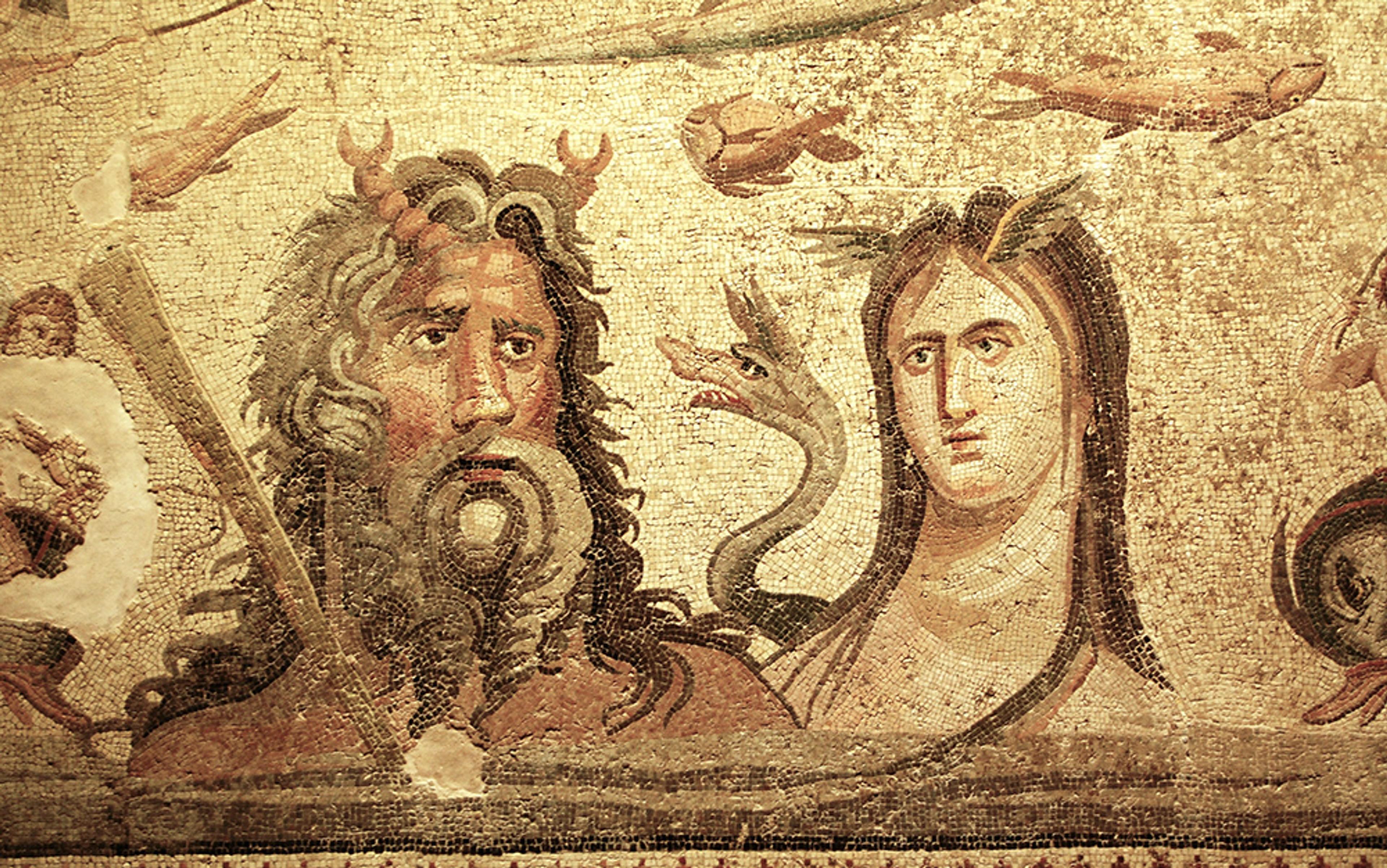
Ocean and Tethys in mosaic floor tiles. Courtesy Wikimedia
There was more to Ocean’s iconography than vases and tile floors; there were also the maps, on which Ocean appeared in his physical, non-personified form. Thanks to the historian Herodotus, we know much about how these early maps were drawn, though the drawings themselves have not survived. Surprisingly, their arrangement drew from the normally sober historian a rare moment of comic levity. ‘I laugh,’ Herodotus wrote dismissively, ‘when I see the many who have drawn maps of the Earth in a nonsensical way; they make the Earth rounder than one would draw it with a compass, and put Ocean all around the outside; and they make Europe and Asia equal in size.’ The scheme he describes could be illustrated like this:

Why did Herodotus find this so funny? Indeed, I puzzled over his laughter for many months as I hacked away at what became my first published scholarly article, some three decades ago. The map has good Homeric authority behind it, since Homer had similarly placed Ocean around the rim of Achilles’s shield, described at length in Book 18 of the Iliad – a shield that, in some respects, represents a pre-cartographic image of the world. Did Herodotus really have the temerity to scorn such a time-worn mythic tradition, enshrined in the Greek world’s most revered literary text?
One clue to Herodotus’s mirth, it seems to me, lies in the satiric phrase ‘rounder than one would draw it with a compass’. There’s too much perfection in this geometry. Actual features of the Earth, Herodotus seems to imply, do not form perfect circles. Achilles’s shield might have formed a circle, but the fact that Ocean stood at that shield’s perimeter has no cartographic significance. Similarly, the exact symmetry of ‘Asia’ and ‘Europe’ – taking ‘Asia’ (as many Greeks did) to mean the southern half of the world, including Africa, and ‘Europe’ the northern half – seems to Herodotus all too simple.
A second problem Herodotus has with Ocean stems from the historian’s concern with the reliability of his information. No one, he asserts in a separate discussion, has ever seen the waters of Ocean lapping at northern Europe, or eastern Asia. So these two regions, for all he knows, might well be connected to some further landmasses that make the Atlantic and the Pacific – Herodotus knew of the first name, but not the second – into two disconnected bodies of water. Indeed in another passage, a discussion of the river Nile, Herodotus goes so far as to call Ocean an out-and-out lie: ‘I don’t know that any river Ocean exists, and I think that Homer or some other of the early poets invented the name and introduced it into his poetry’. This bold assertion might just be the first ever attempt, in the Western tradition, to distinguish between two literary modes, fiction and non-fiction, or to assert a doctrine of ‘poetic’ licence governing the former. For a 5th-century Greek, whose contemporaries revered Homer as a divinely inspired and nearly omniscient bard, this was a radical challenge.
Ocean formed an alternative universe, complete with exotic peoples and monstrous life forms – the kind of realm we moderns locate in outer space
Homer, moreover, had not only shown Ocean as an ornamental shield’s border, in the Iliad, or described Ocean as the ‘father of the gods’. In the Odyssey, he had taken Ocean as a setting for some of the voyages of his hero – the route by which Odysseus was said to have reached the land of the dead, for example. Herodotus didn’t follow his own argument through to its logical conclusion – that the voyage to the underworld in Book 11 of the Odyssey, and perhaps all of Odysseus’ wanderings, must also be fictions. But a later geographer named Eratosthenes pressed Herodotus’s argument home in exactly this way.
The entire tale of Odysseus’ wanderings, Eratosthenes claimed – including such memorable episodes as the Cyclops, the six-headed monster Scylla, and the Lotus-eaters with their intoxicating fruit that takes away all desire for effort or action – was nothing more than an exokeanismos, an ‘Oceaning-out’ of the narrative line. Readers might derive pleasure from it, but they couldn’t learn about the geography of the Earth from it. For Eratosthenes, Ocean therefore became associated not only with fiction, but with the kind of wholesale inventions we today group under the rubrics ‘science fiction’ and ‘fantasy’. It formed an alternative universe, complete with its own exotic peoples and monstrous life forms – the kind of realm we moderns, almost invariably, locate in outer space.
What ancient mariner would dare to sail upon this alien element, a place that, depending on what literary sources one relied on, might be either infinite, or unimaginably old, or not there at all? Only a few ancient explorers, to our knowledge, ignored the warning signs at the Straits of Gibraltar – the so-called Pillars of Hercules, set there to tell humankind they must go no farther – and ventured out into the unknown Atlantic. Their acts of bravado however deeply impressed their contemporaries.
Hanno the Carthaginian, in the 5th century BC, led a fleet of 60 ships, supposedly manned by 30,000 of his countrymen, out through those Pillars and south along the coast of West Africa. His log of the journey, titled Periplus or ‘coasting voyage’, still survives, thanks to an anonymous scribe who translated it out of Punic and into Greek. Among the marvels he describes are encounters with hairy wild men whom the indigenous tribes called ‘gorillas’. Hanno’s men pursued and caught some of these to bring home alive, but they bit and scratched so intractably that the party settled instead for their flayed skins. In the 19th century, European explorers who first encountered the great apes of the African interior adopted this obscure word from the 5th century BC as the name of the new species.
Another party of Carthaginians reportedly sailed due west through the Atlantic and found a fertile, temperate land on the other side, but their discovery – of Greenland? North America? – was hushed up by the rulers of Carthage, who feared a mass emigration. The story is repeated in a minor Greek philosophic work of the 4th century BC, and cannot be substantiated. This has not stopped some from claiming a Phoenician discovery of the Americas, or supporting a Punic interpretation of various artefacts and rock carvings found in the New World, or arguing (as one numismatist did in 1996) that certain Carthaginian coins of the 4th century BC contain a schematic map of Europe and the Americas. Thus far, none of this ‘evidence’ has panned out. If any ancient mariners did manage a transatlantic voyage, it might have been in the opposite direction: a well-attested Roman account of ‘Indians’ whose boat washed up on the shores of the Baltic could in fact refer to a crew of shipwrecked Inuit.
The terrors of the Atlantic were so intense in the 5th century BC that a condemned prisoner might be sent there in place of the death penalty. Such was the fate of the Persian nobleman Sataspes, accused of raping the daughter of a high-ranking official and sentenced to be killed by impalement, according to Herodotus. Sataspes’s mother interceded for her son’s life and convinced the reigning king, Xerxes, to send Sataspes instead on an exploratory voyage to prove that Africa could be circumnavigated. Assigned an Egyptian ship and crew, Sataspes followed the route formerly taken by Hanno, out through the straits of Gibraltar and south along the African coast. Men of small stature, wearing palm-leaf fronds for clothing, ran from him whenever his ship approached the shore. After months of travel, with no sense of how much more lay ahead, Sataspes turned around and headed back to Persia. Xerxes did not buy his excuse, that the ship had been stopped in mid-course and prevented from moving forward. Sataspes’s sentence of impalement was carried out.
As time went on, ancient navigators became bolder about breaching the barrier of the Pillars. Pytheas, a Greek sea captain from Massilia (modern Marseille), in his now-lost treatise On the Ocean, recounted a voyage north along the coast of Normandy, around the British Isles and, ultimately, into the Baltic Sea. In the far northwestern corner of his route, Pytheas glimpsed a mysterious island in the northern distance that, he was told by the natives, was called Thule. The sluggishness and thickness of the frigid waters impeded his ships, however, and prevented him from exploring this mysterious island (today identified variously as one of the Shetland or Orkney islands, or perhaps Iceland). For centuries afterward, ancient writers invoked the name of Thule to signify the distant, the mysterious, and the unapproachable; the Roman poet Virgil gave it the epithet ultima, ‘furthest’, and imagined it becoming part of the Roman empire led by his imperial patron, Augustus.
While Pytheas was fighting his way through sea slush and pancake ice in the far North, a different Greek explorer – at least, a man who claimed, not uncontroversially, to be both Greek and an explorer – was penetrating the Ocean barrier in the far South.
In the summer of 325 BC, Alexander the Great, after a 10-year campaign of conquest, sailed down the Indus river to its mouth. The body of water he eventually reached seemed to him to be Ocean, pure and simple, not the Arabian Sea as we now term it. Alexander had already done things that had appeared beyond the reach of mortal prowess, defeating armies many times the size of his own, besieging and capturing ‘impregnable’ fortresses, getting a force of some 40,000 through the snow-clad Hindu Kush mountains. Now he faced yet a greater test, a way to prove he belonged in the company of the gods. Believing that no human had done so before, Alexander sailed out onto the vast expanse in a single ship, casting golden cups and bowls into the water as an offering to the god Poseidon. It was a short voyage for a man, but a giant breakthrough for humankind – indeed, a feat as meaningful, for his era, as the first lunar landing was for ours.
Despite the bravado of this exploration of Ocean, Alexander was in fact on his way home. His troops had mutinied some months earlier when asked to march further east, again in quest of the ever-beckoning Ocean, and had forced a return to the safer, more familiar, less rain-soaked regions near Babylon (in India they had become the first European army to experience monsoons). Alexander had consented, but insisted on the drive southward, toward Ocean, before heading west; and, he charted a bizarrely difficult homeward course for his rebellious troops, across the waterless, comfortless coast of eastern Iran (a strip he knew as Gedrosia, today called the Makran).
The 60-day journey was beset by mischance and suffering; Alexander lost more men here than in any of his battles. He himself died, of causes that are still debated, a short while later, in Babylon. To Greek observers, accustomed to see in such events a tragic pattern of hubris incurring divine wrath, it seemed that Alexander had been punished for overreaching mortal bounds. The voyage into Ocean, his last great victory before the Gedrosia disaster, was seen, inevitably, as an offence against the gods.
Almost everything about Alexander’s campaigns got magnified in later Greek lore and legend, but the journey onto Ocean took on especially huge dimensions. Starting with the Alexander Romance, a semi-fictional biography of the Macedonian king that took shape in the first two centuries AD, this journey was reimagined along the lines of Jules Verne’s 20,000 Leagues under the Sea (1870): Alexander was portrayed exploring not just Ocean’s surface but its depths, by lowering himself down to the sea floor in a primitive bathysphere. He brought with him a supply of food and unlikely animal companions: a rooster, whose crowings at each new dawn would help him count the passage of days, and a cat, a creature thought capable, in medieval superstition, of recycling carbon dioxide into breathable air. A dog sometimes also joined the menagerie, to be used as a kind of escape button. Since it was understood that the sea could not tolerate mammalian blood, Alexander could, in an emergency, cut the dog’s veins and force Ocean itself to expel his undersea craft.
The common thread is rejection by Ocean: the final frontier would not allow its mysteries to be unveiled
Medieval illustrators of the Alexander Romance adored this underwater journey of exploration. Many fine illuminations survive that capture the solitude of Alexander in his underwater craft, the anxiety of those holding his lifeline in the ship above, and the bizarre welter of marine species, even races of subaqueous humans, that the tiny craft encountered on the sea floor:
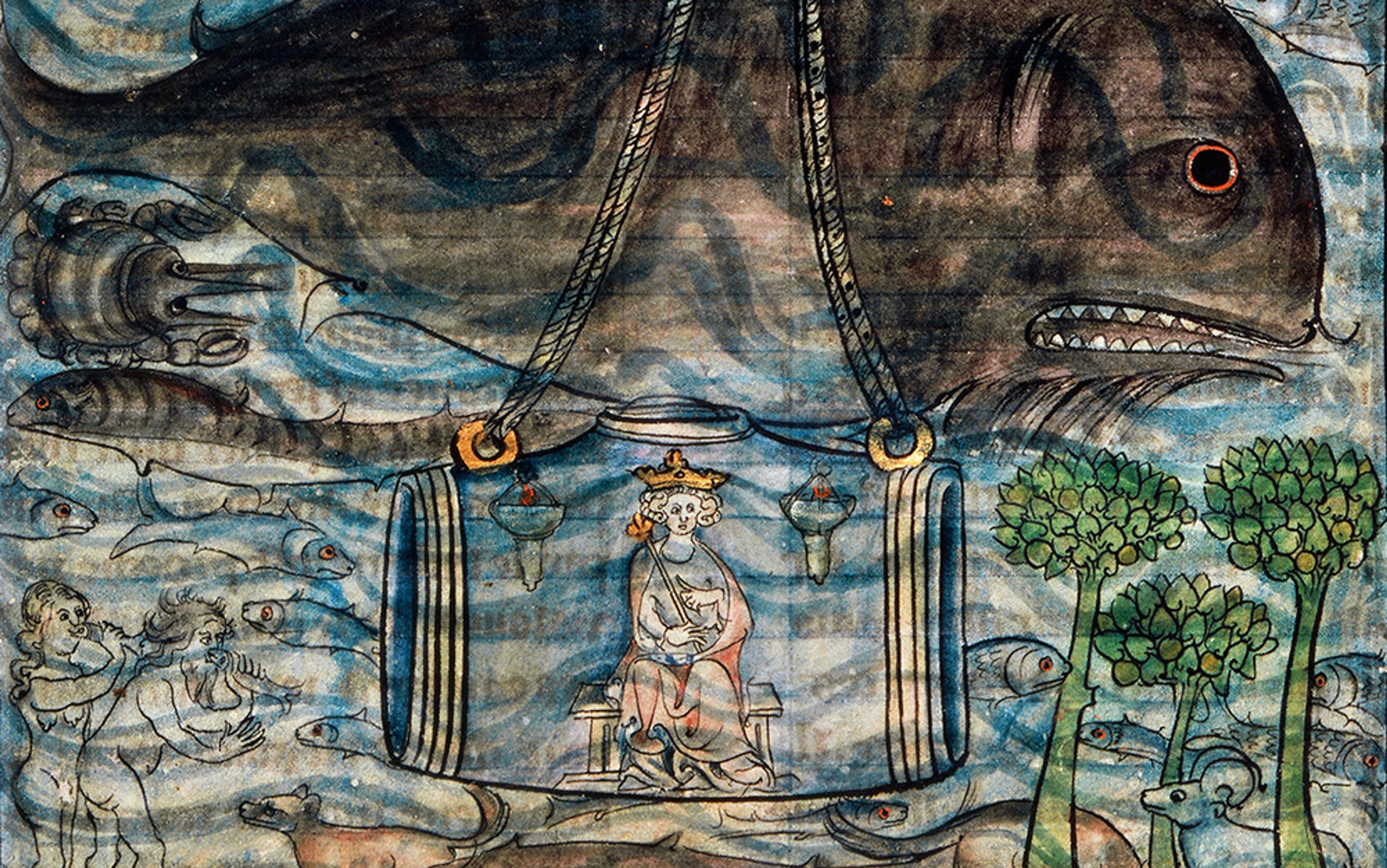
Alexander the Great beneath the waves from the Histoire du Bon Roi Alexandre, French manuscript, 14th century. Photo by DeAgostini/Getty Images
This tale of undersea exploration developed many fascinating variants as the Alexander Romance evolved and spread through the late antique world, eventually becoming, by some estimates, the most widely read ancient literary work other than the Bible. Most versions follow a Jonah-and-the-whale story pattern, in which Alexander’s diving bell is seized by an enormous fish, carried far from the ship to which it was attached, and spit out onto the land, as though the Ocean itself, in bestial form, had denied Alexander its secrets. Other versions imagine Alexander getting into distress through the treachery of his wife, who had been delegated to hold the cord by which his sub was attached to the ship, but who had succumbed to the blandishments of a lover. In these versions, Alexander is forced to use his dog’s-blood escape ruse to get back to dry land. The common thread of rejection by Ocean, or its creatures, unites all these variants. The final frontier, in the end, would not allow its mysteries to be unveiled.
A similar imaginative scheme, in the Roman world of the 1st century AD, is attested by a minor but fascinating text, a rhetorical exercise composed by Seneca the Elder (father of the more familiar Seneca). This public speaker’s practice piece cast Alexander’s sea voyage of 325 BC not as an undersea exploration, but an attempt to cross Ocean, as Columbus later would do, and seek new worlds on the other side. As in the Alexander Romance, Seneca focuses on themes of Ocean’s inviolability, monstrosity and connections to the beginnings of time and the end of space. ‘Whether it is the endpoint of land, or the boundary of nature, or the most ancient of elements, or the origin of the gods, this water is too holy to be crossed by ships,’ says Artemon, a high counsellor in Alexander’s retinue, in order to dissuade his chief from attempting the crossing. Another advisor, Fabianus, warns gravely about the belvae Alexander will encounter on the deep – a Latin word that, like its Greek counterpart kêtoi, can translate to either ‘whales’ or ‘sea-monsters’, for the Greco-Roman world, significantly, did not distinguish between these two meanings.
Seneca’s son, also named Seneca – the Stoic philosopher and tragedian, who also played a central political role at the court of Nero – followed his father’s view of Ocean in his play Medea, a Roman adaptation of the more famous Greek play by Euripides. Seneca’s Medea, unlike its Greek model, depicts the voyage of the ship Argo – the first seagoing vessel ever built, according to mythic traditions – as a primal sin that had brought destruction upon those who sailed in the vessel, and especially those who piloted it. All the Argo’s crew, as Seneca relates in one of the play’s choral odes, meet with grim fates, one by one, as Ocean paid them back; ‘the injured sea has enacted revenge’, as the chorus puts it. Tiphys, the navigator whose skill in reading the stars had made transoceanic travel possible, had been the first to go. Jason, the ship’s captain, as yet remains unpunished, but his wife Medea, whom the play casts as an instrument of Ocean’s wrath, has already by this time set in motion her plot to destroy him. Ultimately, as the mythic tradition had it, he would pay with his life for his seafaring sin, killed by a beam of wood falling from the Argo itself.
Medea was not Seneca’s first meditation on the destructive power of Ocean. As a follower of Stoic cosmology, Seneca believed that the world was doomed for cyclical destructions, every few thousand years, due to natural forces that would swell in intensity until humanity was wiped out. But while orthodox Stoics regarded fire as the agent of these destructions, Seneca alone foresaw a future that would be obliterated by water. In two of his philosophic works, he envisioned how the cataclysm would play out, with waters bursting forth from all sides, both salt and fresh, to overwhelm the land. ‘Nature has put moisture everywhere, so that, when she wishes, she can attack us from all sides,’ he wrote in the Natural Questions. ‘Waters will converge from East and West. A single day will serve to bury the whole human race. The noble, the glorious, the kingdoms of great peoples will all plunge alike into the abyss.’
Ocean was not the only wellspring of Seneca’s watery apocalypse, but the play Medea suggests that it loomed large in his thinking. The play’s chorus of Corinthian citizens, dropping their dramatic masks and speaking instead as Romans of Seneca’s own times, sing of the future that lies ahead for the world, as ships and navigators fare further than even the Argo had dared. ‘An age will come, in later years,’ they say, ‘when Ocean will undo the bonds of things; Tethys will disclose new worlds, and Thule no longer be last among lands.’ In the play’s transmission through the hands of later scribes, the name Tethys became corrupted to Tiphys, such that the passage seemed to predict that a great navigator, rather than the wife of Ocean, would reveal the ‘new worlds’ of the future – an error that, in the Renaissance, seemed to give the whole passage an uncanny relevance. ‘This prophecy was fulfilled by my father Christopher Columbus in the year 1492,’ wrote the explorer’s son, in Latin, in the margins of a family copy of Seneca’s play.
Seen in the contexts of its own times and of Seneca’s gloomy Stoic beliefs, the passage has far darker overtones. Ocean and Tethys were no friends to humankind, but rather agents of the apocalypse that would destroy the race and end its ceaseless strivings. Penetration of the Atlantic would help bring on the cataclysm. The element that marked the end of land, the final frontier, here also marks the end of days, and the close of human history. ‘The origin of all things,’ as Homer had termed Ocean in the Iliad, would, in Seneca’s view, bring cosmic time back to its starting point and ‘undo the bonds of things’ – returning the universe itself to primal chaos.



